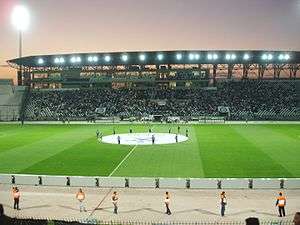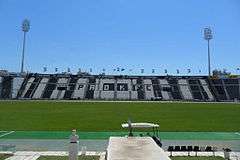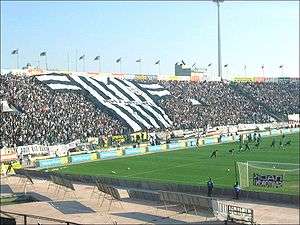Toumba Stadium
 | |
| Location | Thessaloniki, Greece |
|---|---|
| Coordinates | 40°36′49.82″N 22°58′20.72″E / 40.6138389°N 22.9724222°ECoordinates: 40°36′49.82″N 22°58′20.72″E / 40.6138389°N 22.9724222°E |
| Public transit | Papafi station (2020) |
| Owner | P.A.O.K. |
| Operator | PAOK F.C. |
| Executive suites | 14 5-man suites each 12 |
| Capacity | 29,000[1] |
| Record attendance | 45,252 (19 December 1976, PAOK vs AEK) |
| Field size | 106 m × 71 m (348 ft × 233 ft)[2] |
| Surface | Grass |
| Scoreboard | LED |
| Construction | |
| Broke ground | 1957 |
| Built | 1958–1959 |
| Opened | 6 September 1959 |
| Renovated | 2004, 2013 |
| Expanded | 1962, 1965, 1972 |
| Construction cost | ₯ 6,000,000 |
| Architect | Minas Trempelas |
| Structural engineer | Antonis Triglianos |
| Tenants | |
| PAOK (1959–present) | |
| Website | |
| PAOK FC official website | |
Toumba Stadium (Greek: Στάδιο Τούμπας) is a football stadium in Thessaloniki, Greece. It is property of AC PAOK.
History
The construction started in 1958 and completed in 1959. Patrons on the project were the Ministry of Culture and Sport (Greece) which offered the amount of 1,100,000 drachmas, while the Hellenic National Defence General Staff owned the space and contributed decisively to expropriate it for the stadium.
The then defense minister Georgios Themelis vouched for the expropriation of the area of Toumba Stadium during the Konstantinos Karamanlis government in 1958. The old stadium of PAOK in Fountain Square downtown was expropriated for the construction of the Theological School of the Aristotle University of Thessaloniki. The architect of the project was Minas Trempelas and the engineer was Antonis Triglianos. Important for its construction was the contribution of the fans, who were invited twice to assist financially through the "Special Fund for the Construction of the New Stadium of PAOK", while some friends of PAOK worked personally during the process of the construction. It was finished on 6 September 1959 as the club's prime sporting venue and served as the home ground for the club's football team, which was participating in the then HFF Panhellenic Championship until today, for the needs of the Superleague Greece, the Greek Football Cup and the European Cups (UEFA Champions League and UEFA Europa League).
The stadium is located in the district of Toumba in eastern Thessaloniki. Its original capacity was 45,000 until the installation of seating on all stands in 1998, which reduced the capacity to 32,000 (seated). The introduction of security zones in 2000 further reduced the capacity to the current capacity of 28,703 seats. A record attendance of 45,252 has been recorded in a 1st division football match between PAOK and AEK on 19 December 1976. The stadium's official name is simply "PAOK Stadium", however it is commonly referred to as "Toumba" after the district where is located.
2004 upgrade
The stadium has hosted several games of the Greece national football team. The stadium was selected as one of the training venues for the football tournaments of the 2004 Olympic Games, and due to this it was heavily upgraded. The relevant works commenced in 2003 and the stadium was again ready to be used in the summer of 2004 while boasting a brand new look. The most important modification was the construction of a new four-storey building behind the main west stand (Gates 1, 2 and 3). The new building of the stadium houses a number of VIP boxes and VIP lounges, service areas for TV and the press and new club offices. A new roof was also installed over the west stand, while other works included new seats, upgrades for the dressing rooms, a new pitch and re-enforcement of the concrete pillars below the north curved stand (Gate 4 and Gate 4A).
Recent upgrades
After the advent of the new major shareholder Ivan Savvidis in 2012, a gradual renovation began. Big changes began in 2012–13, but most of the changes were made in 2014–15 for the European obligations of PAOK in the UEFA Europa League, starting from the central part of the stadium. A presidential suite was created and a gradual renovation for the media theories for convenience and functionality in the building of the third floor. In early September 2015, the turf was changed.
In 2017, Savvidis announced his plan either for a construction of a new football stadium in the same place or a gradual reconstruction.
Gallery
 Inside view
Inside view.jpg) PAOK vs Olympiakos 1-0 (2009)
PAOK vs Olympiakos 1-0 (2009).jpg) Inside view
Inside view.jpg) Fans
Fans Big shirt in the stadium
Big shirt in the stadium
See also
References
External links
| Wikimedia Commons has media related to Toumba Stadium. |